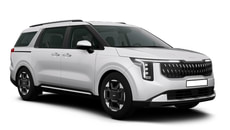Kia will debut a bespoke EV in 2021 as part a £19 billion (about Rs 17.5 lakh crore) strategy to transition to being a maker of electrified vehicles and mobility solutions in the next five years.
The strategy, called Plan S, is expected to help the Korean firm establish “a leadership position in the future automotive industry”. It details planned new models, investment strategies and sales targets.
Kia's all-new, battery-electric car will arrive in 2021, keeping in line with the carmaker's ambition to offer a “full EV line-up of 11 models and reach a 6.6 percent global EV market share by 2025”. Other details are to be confirmed yet, but the model will use a bespoke new platform and is claimed to offer a range of over 500km.
Kia also confirmed the model will feature a “crossover design which blurs the boundaries between passenger and sports utility vehicles”, indicating that it'll be closely linked to the Imagine by Kia Concept revealed last year.
The model is said to be capable of charging in under 20 minutes using a high-speed 800V charger, but a 400V system will be fitted to other derivative models in Kia’s future EV line-up to allow for more varied pricing.
The company plans for EVs to account for 20 percent of its total sales in developed markets (South Korea, North America, and Europe) by 2025. It will continue to promote conventionally fuelled cars in developing regions before gradually introducing electric models.
This approach is anticipated to allow Kia incorporate specific market demands at the product planning stage and therefore tailor each model according to the region.
Kia also aims to achieve a 6 percent operating profit margin by 2025. It expects that high-margin SUV models will account for 60 percent of all sales outside China by 2022, helping fund the development of future technology and models.
In addition to expanding its EV portfolio, Kia will meet the growing demand for e-commerce and car-sharing with plans to develop EV infrastructure in cities that promote the use of zero-emission vehicles.
Alongside the introduction charging points, it has plans to build ‘mobility hubs’ in some global cities that will act as a transfer point between combustion-engined and electric cars before entry into a restricted zone. The buildings will also house charging stations and maintenance facilities.
Further down the line, Kia expects to use these mobility hubs as operating bases for its autonomous taxis and shuttles. These models will sit atop a bespoke self-driving vehicle platform that's set to enter series production in 2024.
There are also plans to target the transport, logistics and distribution sectors. Currently accounting for 5 percent of the global automotive market, customers in these areas are expected to account for 25 percent of all vehicle sales by 2030. Kia will introduce specially adapted versions of its Soul EV and e-Niro before developing bespoke vehicles for the delivery, car-sharing and logistics sectors.
These new vehicles will sit atop a modular, skateboard-style EV chassis that'll use a low-mounted battery and compact motor, and can be adapted for a wide range of vehicle uses.
Coming to the India market, Kia made its debut last year with the launch of the Seltos SUV in August. There's has been a strong demand for the Seltos in India, with sales for the SUV having crossed the 40,000 mark last year.
The carmaker is gearing up to launch its global MPV, the Carnival, at the Auto Expo 2020 that'll be held in February. In addition to this, a sub-four-metre SUV is also due to arrive later this year and is expected to be shown in concept form at the expo.
Also see:
India-spec Kia Carnival image gallery














Comments
Member Login
Personal Details
No comments yet. Be the first to comment.